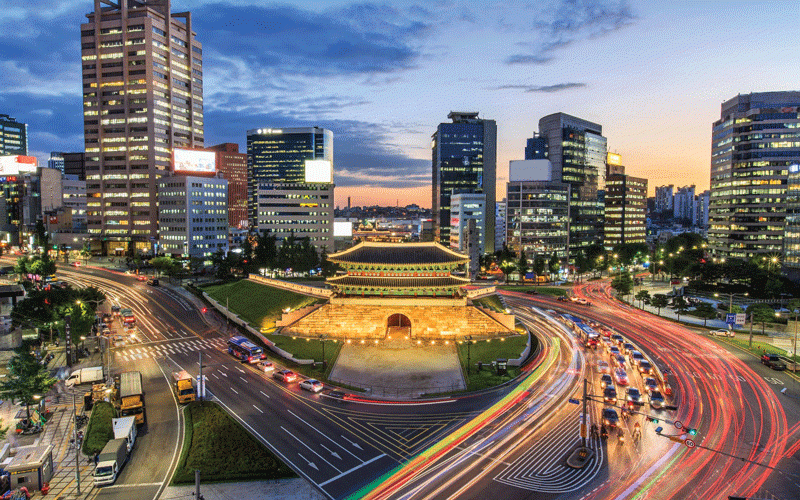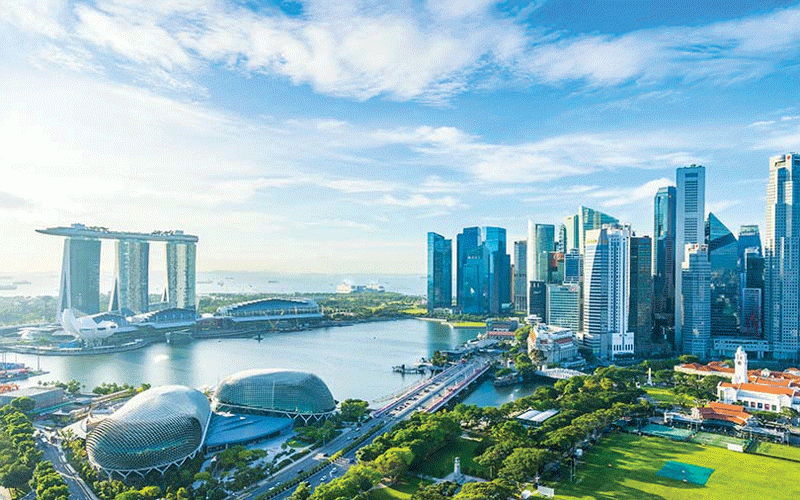
South Korea was established as a country in 1945 when it formally separated from North Korea. The separation particularly made South Korea economically vulnerable. This is because electricity, chemicals, fertiliser, and other raw material industries which South Korea was dependent on, were located in North Korea, at the time.
So, the country started off with very little industrial activity of its own. In fact, in the early 1950s South Korea was one of the poorest countries in the world.
During the 1950s its economy was predominantly agrarian and was heavily dependent on foreign aid, which primarily came from the United States. Industrialisation only emerged in the early 1960s. When the South Korean government introduced its several five -year economic development plans, starting from 1962 to 1966, the country's fortunes began to turn around for the better.
Manufacturing, export - led growth
South Korea's phenomenal focus on growing exports was a major contributor to the country's economic growth.
Before 1960, exports had stagnated at only 1% of gross national product (GNP), which was around US$20 million (in exports) at the time. However, by 1969 they had incredibly reached US$623 million. This remains one of the highest export growth rates on record, globally. The ratio of exports to GNP resultantly reached 10% by 1969, from only 1% before 1960.
Significant exports of manufactured products only emerged around 1962, when they amounted to US$19 million, or 11% of total exports at the time.
By 1969, exports of manufactured goods were no less than 77% of total exports. Agriculture, forestry and fishing which made up 44% of GNP in 1957, became less than 20%, by 1977. Manufacturing rose from 9% to 35% of GNP over the same period.
- Harare mayor bans management foreign trips
- The soccer whiz: Qatar Word Cup 2022, Here we go
- Embassy showcases South Korean movies in Harare
- Croatia beat Japan on penalties to reach quarters
Keep Reading
From 1961 to 2024, the average income of South Koreans rose from only US$120 per year to more than US$36 000.
Manufactured exports were initially dominated by clothing, plywood, wigs and other low value manufactured consumer goods. In 1950, exports of the aforementioned three products accounted for only US$1 million, but they then rose to more than US$300 million in 1969, representing about 63% of total exports of manufactured goods.
Large export industries were built, which focused on only one or just a few products such as plywood, wigs and sweaters. This pre-empted marketing problems by placing these products in just a few foreign markets.
By the early 1970s, electronic products, footwear, steel and synthetic woven fabrics joined the list of major export products.
On the other hand, rapid expansion in Korean shipping, tourist services, remittances from workers in other countries and revenues from overseas construction projects provided a remarkable increase in non-commodity exports.
As of 2022, the country is still a major exporter, although the composition of its greatest exports has since changed to constitute electrical equipment, refined petroleum, vehicles and vehicle parts, other industrial machinery, chemicals and equipment. Service exports have grown significantly through the years, reaching 15,8% of total exports in 2022.
Exports were originally highly concentrated in a few destinations such as the USA and Japan, which received 72% of South Korea’s total exports between 1960 and 1969. This reflected its great dependence on and relative vulnerability to the two export destinations.
Today, South Korea's exports are less concentrated in the two foreign markets, than before, but they are still dependent on a few countries, when compared against other major exporting countries. China (including Hong Kong), the USA and Vietnam received 25,3%, 15,9% and 8,6% of South Korea's exports, respectively, in 2022. So, almost 50% of exports were destined for just three countries. Any social or economic problems within those countries can easily disrupt South Korea's economy. Thus, the country will need to continue searching for new markets for its exports, in order to reduce the vulnerability of concentrating exports in just a few markets.
Impact of government policies
Government policies, particularly those which focused on export-driven economic growth, were the most important factor in the rapid economic development of South Korea. These policies were effected through the five -year economic development plans. Export incentives were actually begun in the late 1950s. But they were much smaller in their range and variety. The exact characterisation of the policies is explained below.
With the five-year development plans, the government primarily aimed for and achieved financial stability.
This is because from 1945, into the early 1960s, South Korea had experienced problematic inflation. Between 1953 and 1959, wholesale prices within the country were rising by an average yearly rate of 27%.
However, from 1963, anti-inflationary programmes were introduced on a sustained and comprehensive basis, with growing sophistication in financial techniques used to implement them.
South Korea abandoned a dishonest and unrealistic formal foreign currency exchange rate, and gradually chose a more realistic valuation, until it reached an ideal one by March 1965.
The aforementioned stabilisation measures led to a lower inflation rate, with wholesale prices increasing only by 7% to 8% per annum by 1965. Industries were therefore enabled to mobilise investments for expanding their facilities with a long-term view.
Labour productivity grew and prices of South Korean goods and services fell, making exports even more competitive. Exporters no longer got short-changed when their foreign currencies were liquidated into local currency by the monetary authorities.
A stable local currency gave citizens greater confidence in the banking system and drove them to begin saving their incomes. The anti-inflationary monetary and fiscal policies had worked.
There was a reduction in or exemptions from various taxes and customs duties for exporters.
For example, there was an exemption on a tax named the “business tax” and a 50% discount on corporate and other income taxes.
In Zimbabwe, corporate income tax is levied on 26% of a company's net profits. So, a 50% discount on such a tax would imply that exporters would now be required to pay only 13% of their profits as corporate income tax.
The South Korean banking system, which was controlled by the government at the time, provided exporters with loans at preferential interest rates, compared to loans for companies which served the domestic market.
In the 1960s, exporters accessed credit at an interest cost of only 6% per year, against domestic companies which were charged a huge 26% per year.
Taxes paid by exporters were further reduced through enabling the entry of new additional expenses such as accelerated depreciation on facilities used for the production of exports.
This meant that the income of exporting companies was manipulated to appear much lower than it was and thus made it possible for them to reinvest it into the expansion of their businesses. The government offered exporters discounts on electricity, railway and the use of the country's ports.
Raw material imports to be incorporated in exports were exempted from import duties and other commodity taxes. Exporters were granted one year monopoly export rights for the introduction of new products or opening of new foreign markets.
This meant that they could exclusively serve a new export market without competition from their home market for up to a year.
This resulted in lucrative profits particularly within the first year with the monopoly rights and it incentivised locals to search for new export markets and develop innovative products for the export market.
Spoilage and waste allowances were allowed on imports which were to be used by exporters in their production processes.
This effectively reduced tax payable, when invoked by the exporter, and made production more efficient and less risky. There was also the automatic granting of foreign exchange in official markets, for the imports of raw materials to be used by exporters.
This meant that exporters, instead of importers, were given preferential access to foreign exchange.
The government chose this path because exporters would eventually surrender their foreign currency to them, upon the receipt of their revenues from the foreign markets.
Resultantly, South Korea managed to build up abundant foreign currency reserves through the years, which stood at US$415 billion at the end of 2024.
Export marketing assistance was provided in the form of trade information from the Korea Trade Promotion Corporation, which was established in 1962 and through diplomatic missions abroad.
The government set out to formulate annual export targets, with a focus on growth, in consultation with the private sector.
By the 1970s, South Korea's ministry of commerce and industry (MCI) would announce export targets for each year. MCI and other export administration staff could work days a week, even putting in over time, if the targets seemed difficult to meet.
Effort would be focused on expediting administrative export processes, strengthening existing export support schemes, introducing new subsidies and exerting pressures on entrepreneurs to accelerate production.
The president of the republic personally attended and chaired the meetings pertaining to the export targets, which revealed his commitment to the endeavour.
Other factors
Cheap and efficient Korean labour force meant that investors would get their profitable returns quicker and almost guaranteed. The native intelligence, rigour, high level of general education and functional and extensive vocational training made Korean workers competitively skilled, hardworking and dependable.
This was critical, especially in the 1960s because the majority of the country’s exports were mostly labour intensive, at the time.
Abundant labour in South Korea, particularly in the 1960s, meant that wages were generally lower than in other countries at a similar stage of development and also in developed economies.
The absence of strong labour unions implied that the rate of wage increases in the labour market was kept well below labour productivity growth.
So, South Korean companies were rarely disrupted by unreasonable wage demands. The emergence of dynamic Korean entrepreneurs was greatly helpful, as local business people competed with, acquired useful knowledge from, and participated alongside foreign investors in the growth of exports and their economy.
Ultimately, Korean entrepreneurs emerged, who now participate in the world's economy through building ships and bidding for the construction of infrastructure in other countries.
Favourable economic conditions in US, Japan and other importers of South Korean products, such as economic growth and high incomes, made it possible to sustain robust demand for Korean products.
Also, the relatively challenging conditions in competing nations, whose exports competed with South Korea on the global stage — such as high costs of production, inflation, labour productivity, and poor innovation — meant that Korean exports remained competitive.
The restoration of diplomatic and favourable relationships with major trade partners such as US, Japan, and others, meant South Korea could access more foreign direct investmentas well as credit for export industries and markets.
- Tutani is a political economy analyst. — [email protected]











